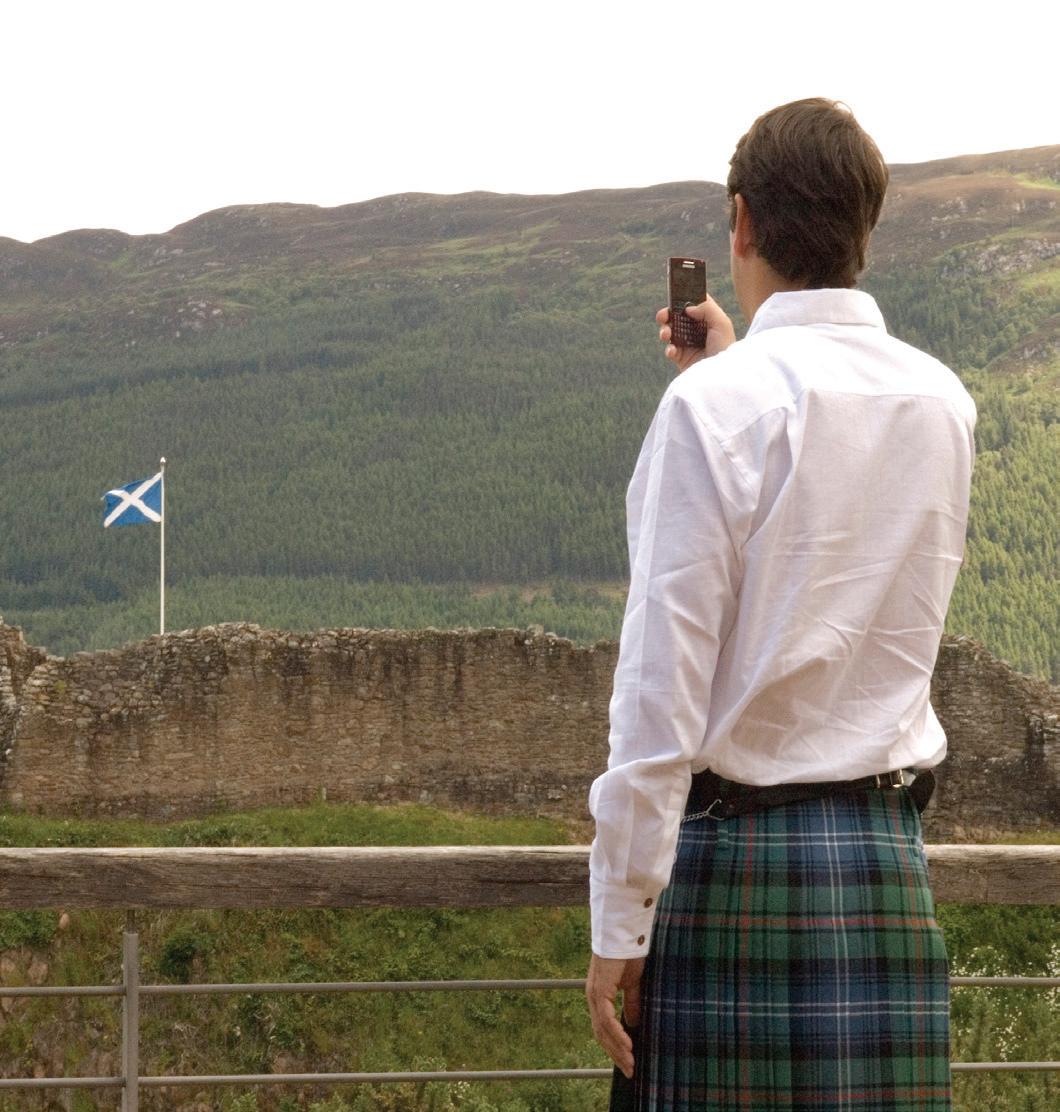
23 minute read
COMMUNITY HIGHLIGHTS
FROM THE PUBLISHER
On July 29, 2020, Tim Gilmore published a story on his blog about Johnnie, the St. Johns River Monster. It reminded me of the commercials we used to see on television for the books, “Mysteries of the Unknown,” which aired through the 80s and 90s. I also immediately thought of the Folio Weekly I knew and loved. It was one of those stories. We had to make Johnnie a cover story. Tim sent it to us two days later and I read it again, wishing revenue existed to print stories like this weekly.
I could see the old me, or the new me, opening up the Folio and learning about Johnnie - whether in 1988 or 2020 or 2040. Tim wrote a timeless story which science has largely disproven. Of course, if The Creature from the Black Lagoon started walking up to riverfront home in Ortega or San Marco, he’d likely be dead from a gunshot before he got to the back door. I prefer the more dinosaur or manatee looking depictions of Johnnie. Imagine being on the river and seeing that stare back at you. I’d likely be dead from a heart attack before I got to the back door.
Many generations ago, members of the Urquhart family gathered at their castle overlooking Loch Ness, the legendary home to Nessie. One of my sons has the middle name “Hart,” short for Urquhart, as a tribute to our Scottish genealogy. I have been atop the castle ruins and anxiously hoped to see something science (and sonar) proved was likely only fantasy. I was thrilled to know the St. Johns had a similar majestic beast. I occasionally miss wondering about the mysteries of the unknown and imagining my own explanations.
The planet still has plenty of mysteries, and it’s good for us to hang on to some. It is good to stop and wonder. We need to recognize our lack capacity to really understand why we are all spinning around the cosmos on this one particular rock.
I am glad our friends at the Jacksonville Jumbo Shrimp honored the river’s diminutive residents, but I am imagining “the Johnnies,” “the sea monsters” or the like to be our next athletics team.
We hope you enjoy the diverse stories in this month’s Folio 2.0. We invite you to contribute, to imagine and envision how we can better help each other, our communities and our planet. But we also hope you will just take a moment to wonder what you’d do if you saw Johnnie staring back at you.
JOHN M. PHILLIPS
PUBLISHER AND KID AT HEART
ABOVE: PHILLIPS IN SCOTLAND
THE MAIL:
SUPPORT RENAMING PARKS
Please vote no on CM CM Diamond introduced Diamond’s proposal to freeze legislation that would freeze the renaming of any park or the renaming of any park or building. That would eliminate building for the next two years a source of funding for or until a new process was maintaining public parks. created. That legislation will
Many local philanthropists be considered by the council are encouraged to give to next month. the community when they Please propose legislation somehow personally benefit. that will acknowledge that the
I hope you’ll encourage promotion of or participation philanthropists to commit to a in human trafficking is so yearly contribution to maintain abhorrent in our modern times a park in exchange for naming that no one who facilitated the park. There should also be human trafficking should have a rule to automatically rename a park named after them. the park after the street it is Slavery is another name for on if the yearly contribution human trafficking. should end. SUSAN AERTKER
SECURE OUR ELECTIONS
After trying out many flawed voting systems, Florida finally has a “digital scan system on all its voting machines in every county.” According to Joseph Geller, a state legislator, “This technology was designed by the manufacturer ES&S to help with audits and recounts.”
Unfortunately, over eight Supervisors of Elections in the largest counties in Florida, including Duval County’s Mike Hogan, have chosen to turn off the default setting for saving the ballot images. If a recount becomes necessary, Duval County will have to do the recount using cumbersome paper ballots, rather than employing the equipment’s back-up memory sticks containing every ballot image.
Close races occur in Florida; ballots get lost or fail to be counted almost every time. The benefit of saving the ballot images as they are initially scanned into the voting machines would seem obvious. But it isn’t obvious to Mike Hogan.
If our SOE agreed to save all ballot images, voters would have reason to feel more confidence in the integrity of the count; and the SOE would have an easier task. A recount employing ballot images would be faster, more economical and safer.
These new voting systems scan all ballots, whether voted by mail or voted in person. These images are not photocopies. They are the vote-counting basis for the determination of the election. Why would Mike Hogan want to create skepticism in the minds of the voters?
INDIVISIBLE MANDARIN
HOW TO
g WU b 4U e f 4Wc X YN4
EB Pull out your smartphone

F B4 On iPhone, open your camera. For Android, download a QR code scanner from the app store.
GB4 On iPhone, point your camera towards the QR code and click the dropdown link that appears. For Android, follow the prompts of the app.
d á u wâ } wy 4 Ç uÄyà Öy á z y wâ N4
BRICKBATS + BOUQUETS
BRICKBAT TO DEPT. OF HEALTH As back-to-school season approached, the FL Department of Health attempted to block crucial data on COVID-19 cases in schools from being released. Thankfully, local journalists like Emily Bloch pressured the DOH and districts to publish the data.
BOUQUET TO JWB REAL ESTATE CAPITAL While so much downtown development unfortunately focuses on demolishing and replacing existing buildings, JWB has chosen to keep the existing character of their new downtown assets while updating them for modern business. That’s a win for the historic nature of Downtown Jax.
BOUQUET TO LOCAL SHOPS TAKING A STAND
Local retailers like Bold Bean, Community Loaves, Vagabond Coffee, 1748 Bake House and more have taken to supporting organizations like the Evac Movement, JCAC, and the Southern Coalition for Social Justice through resource links and donations. Shout out to their employees for facilitating tough conversations, too.
THE LAUNDRY PROJECT
CLEAN CLOTHES ARE A FOUNDATION FOR A GOOD LIFE.
As Florida trudges its way through a pandemic, many of its citizens have grappled with unemployment and struggled to pay their bills. Last month’s JEA bills also skyrocketed, leaving a rising amount of Duval scrambling to adjust their budgets for necessities and back to school.
Laundry is one of these necessities. Whether it’s from home, adding to the electric and water bill, or a trip to the laundromat, clean clothes can cost a pretty penny. Fortunately, Jacksonville may find some relief with an affordable laundry initiative from Tampabased Jason Sowell, who runs the nonprofit Current Initiatives and started the Laundry Project. “About 12 years ago I was in LA visiting some friends who worked with homeless people at the time, and they took one of the guys to a laundromat to wash his clothes. While I was there I talked with some families that were single moms and just struggling financially. I learned from them that a lot of families are having to decide between buying groceries or washing their clothes, and I fortunately didn’t have to grow up like that. It’s a choice I don’t think anyone should have to make but it’s a real choice for a lot of families. So when I came back to Tampa I started the Laundry Project. I wanted to do what I could to provide some relief to that financial burden to families and individuals in need,” he says.
Though it may sound daunting to get a community initiative off of the ground, Sowell has been running the Laundry Project with great success for over a decade, crossing state lines. “We started the project 12 years ago at one laundromat and have since grown to providing it in 11 states across the U.S.” With these astonishing and inspiring figures, Sowell hopes that Jacksonville will follow suit. He expanded his project and launched it in Jacksonville around 7 years ago and plans to reach into the Jacksonville Beach area, but more people in the area could benefit from it. “Jacksonville can help by working with us to get financial sponsors. We like all of our projects to be funded locally by individuals and local businesses. We use a lot of laundry supplies such as soap and bleach and softener so people can donate that and/or donate financially to put quarters in machines for these families.”
But how likely is it for Duval to get the free laundry project, amidst a pandemic? “Usually these projects are pretty open to the public on a first come first serve basis and we advertise through the laundromat,” Sowell explains, “During the pandemic we’ve

A volunteer with the Laundry Project.
had to retool a little bit and we have families sign up for time slots throughout the day to keep to social distance and safety guidelines. Families can contact us and we get them signed up via email, social media or text. We try to make it as accessible and easy for families as possible.”
This assurance and initiative comes as a relief for many local families. Want to get involved? Volunteers are welcome: “We have some incredible local volunteers and supporters who are fully invested that continue to help us do more in Jacksonville and on a regular basis.” Should Duval utilize the Laundry Project in action, no longer will many be scrounging for change in couch cushions or desperately digging into jean pockets for a spare quarter. With a helping hand and a plan, it’s finally time to wash, dry, fold and relax - and to put that spare change aside for a rainy day. CASEY CRAIG STORIES@FOLIOWEEKLY.COM
For a list of city and community resources during the COVID-19 pandemic, visit https://www.coj.net/recoveryresources.







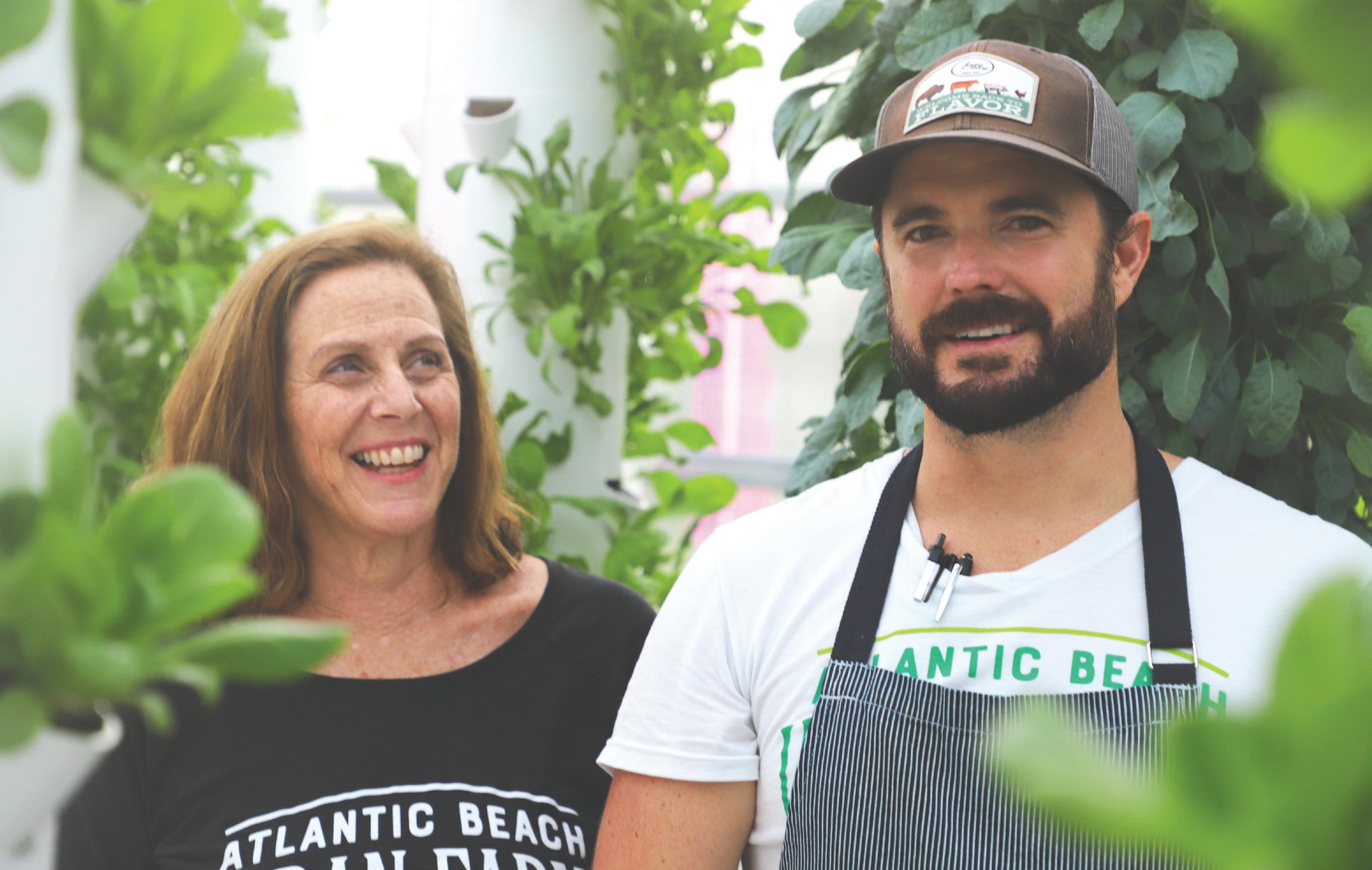
GREEN THUMBS IN THE CITY
GROWING AN APPRECIATION FOR URBAN FARMING IN ATLANTIC BEACH.
“If it came from a plant, eat it; if it was made in a plant, don’t,” author Michael Pollan once said. For some, this thinking leads them to seek out organic, locally-sourced produce — and ultimately to the doorstep of Atlantic Beach Urban Farms on Atlantic Boulevard.
In the case of Trey Hartinger, 39, the chef at Atlantic Beach Urban Farms, being hired to work at the greenhouse was the result of a passion he’s harnessed through varied working experiences. After graduating from high school, Hartinger joined the Marines and was stationed in California, he then later attended culinary school and served in restaurant management roles while exploring a budding music career.
Yet, after a request from his sister in 2009 to relocate to Jacksonville to spend more time with family, Hartinger packed his bags and headed east. Before arriving in Jacksonville, he had put out some employment feelers to area restaurants, and ended up landing a job as a chef at Marker 32.
After 10 years working and building relationships at Marker 32 and another Jacksonville family farm, Congaree and Penn, Hartinger’s passion for sustainable farming had fully manifested itself. Combining his cooking expertise and sustainable sourcing efforts, he remained dedicated to sourcing from local foodways whenever possible — and that’s how he met Tracey Westbrook, while buying lettuce. She is the owner and co-founder of Atlantic Beach Urban Farms.
SLOW FOOD: food that is produced or prepared in accordance with local culinary traditions, typically using high-quality locally sourced ingredients.
Westbrook, who founded the farm in 2014, says she came up with the urban farming idea based on her love of community outreach. The 57-year-old Jacksonville native wanted her neighboring residents to have access to fresh food without having to leave their community to get it.
“Urban farming provided the technology that allowed us to bring farming into the Atlantic Beach community without much farm space. Our model is really set up to demonstrate what this new technology can do,” Westbrook said.
Each day, this Controlled Environment Agriculture technology is what enables her plants to grow in vertically-stacked layers across the greenhouse. Using a rotating system, the plants on one side begin to germinate, while the ones on the other side have flourished and will soon be ready for harvest.
Before COVID-19, Westbrook and her team were selling most of this produce commercially to area restaurants and within their own farm market. They rented out the farm for events, but as of March, the coronavirus forced them to shift gears.
“We lost 70% of our revenue, and had to figure out a way to reinvent the business,” Westbrook said. “We started to expand our retail market and wanted to add culinary offerings. [Hartinger] was the first person I thought of because he is not only one of the best chefs in Jacksonville, but an amazing ambassador for the Slow Food Movement, which supports and recognizes local food cultures and traditions.”
Now, Hartinger and Westbrook work together to produce and craft delicious, locally-grown meals for the community to enjoy. Some of the meals Hartinger has prepared include homemade roasted chicken gnocchi, roast chicken cassoulets, deviled sea scallops and white bean ravioli. Atlantic Beach Urban Farms’ Farm Market shop also sells cheese, charcuterie, and imported oils and vinegars from artisan farms in Italy (all of which Westbrook has visited).
To come up with sustainable meal ideas, Hartinger says he must first determine what’s available from the greenhouse and farmers, and then he gets creative. He’ll incorporate customer demands using the available tools, with seasonal produce at hand.
“We’re trying to grow our own food, and if we can’t grow it we’re trying to source it as responsibly as possible,” Hartinger explained. “I try to keep things super-approachable, but use techniques I’ve learned throughout the past two decades to help focus on the representation of the season. I want to give [community members] something they’re never going to forget.”

While customers can purchase meals directly from Atlantic Beach Urban Farms’ Farm Market, Hartinger stresses that customers should not forget about the farmers. He says it is concerning that farmers never seem to receive the amount of credit they deserve for their labor.
“It’s all about the farmers, we have the easy part of the job. We take the stuff they’ve spent years growing and spend 10 minutes with it,” Hartinger said. “People give us the acclaim, but the farmers deserve a lot more recognition because if their crops don’t come up and produce, it creates a detrimental wrinkle effect in the foodways. The more people actually shop local, the stronger the foodways become, and the more prosperous the actual producers of food become.” LINDSEY NOLEN
FROM LEFT: BRIANNA KILCULLEN, GIGI LUCAS, AND MALCOLM JACKSON IN SPRINGFIELD
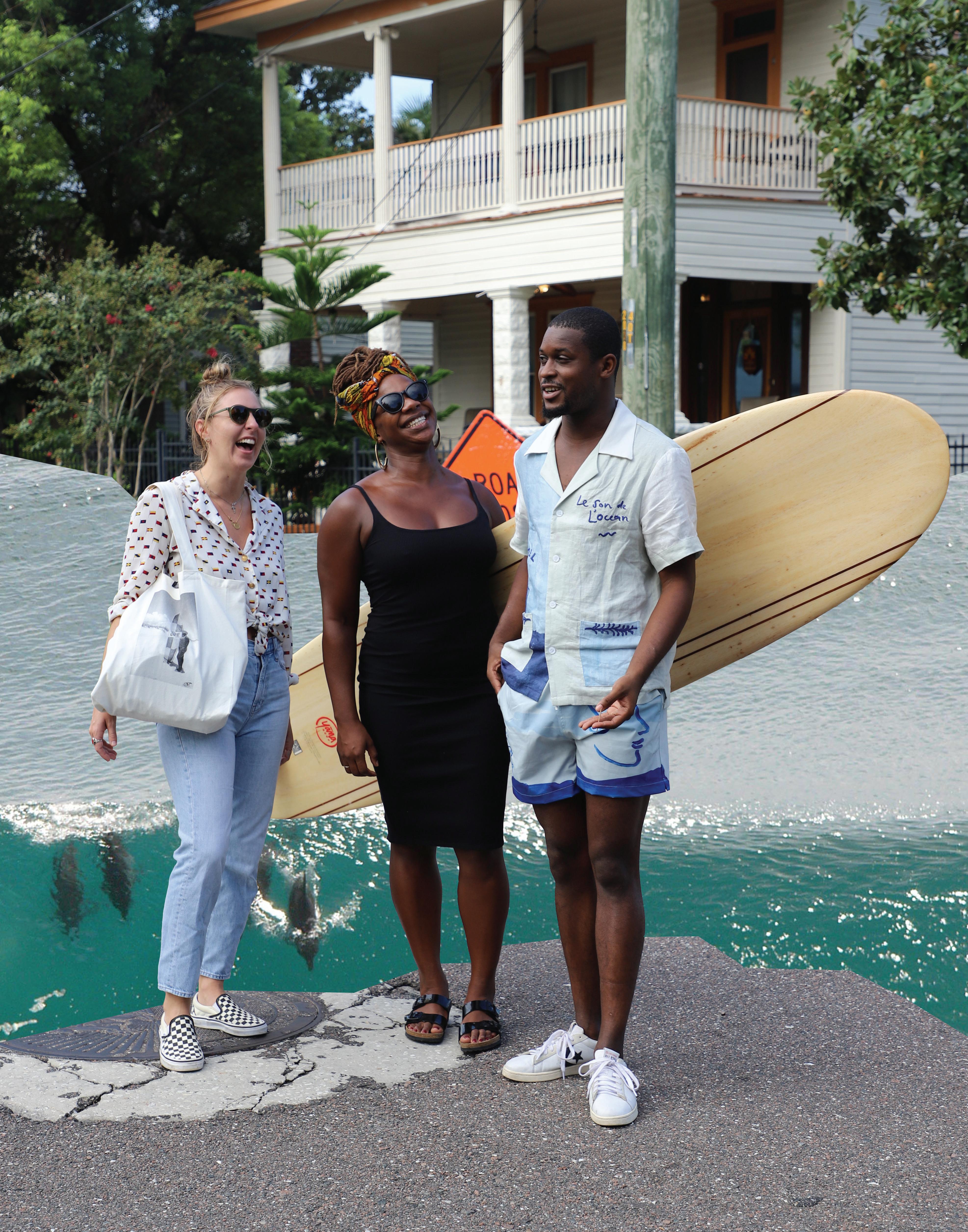
BY JOHN ALOSZKA
SURFING THE DIVIDE
BLENDING SUSTAINABILITY, PHOTOGRAPHY AND SURFING TO COMBAT INEQUALITY
A local company, artist and surfing organization are working together to bridge the gap between underrepresentation in aquatic sports and sustainability. “ANACT is short for an act of kindness, an act of goodwill--we want to inspire anyone who uses our product to take simple acts that create impacts. We were funded on Kickstarter in September of 2019, out of UNF’s Innovation and Entrepreneurship Center here in Downtown Jax,” said Brianna Kilcullen, the founder of ANACT.
According to Kilcullen, ANACT’s products were designed to solve problems and better the environment. Products are 55 percent hemp and 45 percent organic cotton. The average product saves around 300 days of drinking water and the tote bags get rid of single-use plastic.
The company has partnered with SurfearNEGRA, an organization focused on bringing cultural and gender diversity to the sport of surfing. The organization provides awareness, education and access to girls of color who are interested in surfing.
Founder and Executive Director of SurfearNEGRA, GiGi Lucas, says her mission is to create enough access for the next generation to get into the sport and raise awareness around the lack of diversity in surfing.
“I think that with African Americans particularly, it was disrupted with the slave trade, Jim Crow laws and then the Civil Rights Movement. As you know, we weren’t legally allowed to go to the beach until 1968, which is only 52 years ago so with that being said it was highly unlikely for a couple of generations to develop a relationship with the water, to have an aquatic lifestyle, to learn how to swim, to pass it onto generations, much less, learn how to surf,” said Lucas.
According to Kilcullen, the partnership started when she met Malcolm Jackson, a photographer in Jacksonville who photographed Lucas. “I went to his exhibit in February and I saw a photo of Gigi with her surfboard. Malcolm did a quick plug and mentioned Gigi and her work, and I immediately wanted to be friends with her and connect because I felt there wasn’t anyone doing such cool work in Jacksonville,” said Kilcullen.
The two organizations officially became a partnership following the death of George Floyd, after realizing they had the similar missions. ANACT then created a tote bag with a picture Jackson took of Lucas. A percentage of the proceeds go toward SurfearNEGRA. Each tote bag sports a poem by Lucas about her experience as an African American woman making waves in the Black community.
According to the World Surf League, 0.2 percent of U.S. professional surfers are women of color.
“We’ve had young girls get to get the bag and be super excited to see that someone who has hair similar to them or looks similar to them do something that they never thought they could do. I think that was really intentionally meant with this project - was how could we inspire people to start being mindful of everyday interactions, racial inequality and to create specifically aquatic equality,” said Kilcullen.
“When we talk specifically about Black girls, there are heavy influences in terms of eurocentric ideas of beauty that impact their hair. A lot of them wear weaves or get relaxers and the more important thing is making sure that they’re seen as beautiful,” said Lucas.
Together the two organizations send girls from different communities around the country to surfing camps and cover the cost, so girls of color can build a connection with the water.
“Growing up in Jacksonville, I’ve always felt like it’s a very racist and archaic culture where people are very segregated and separated, and the people that built this city and this country are African Americans so it just felt like enough was enough of not standing up and bringing awareness to the people who deserve it the most,” said Kilcullen. HEYDI ORTIZ
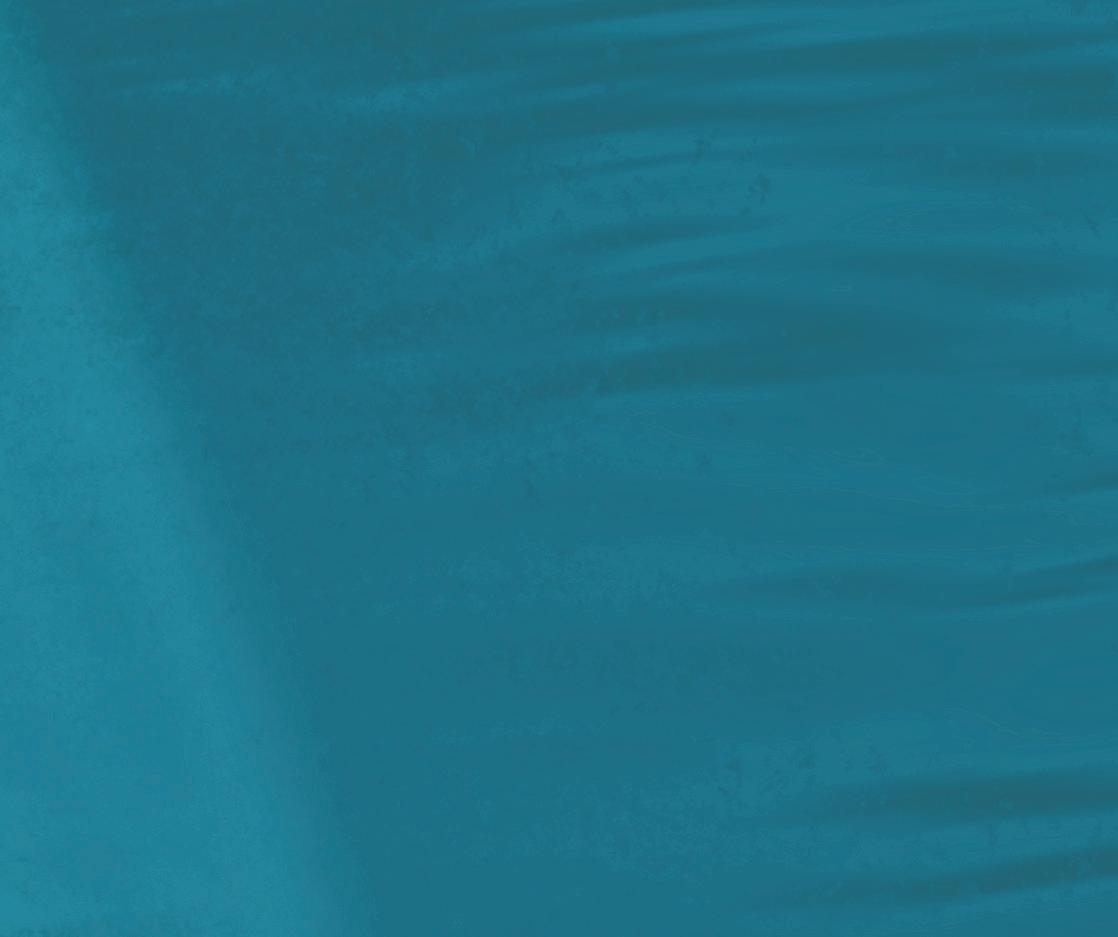









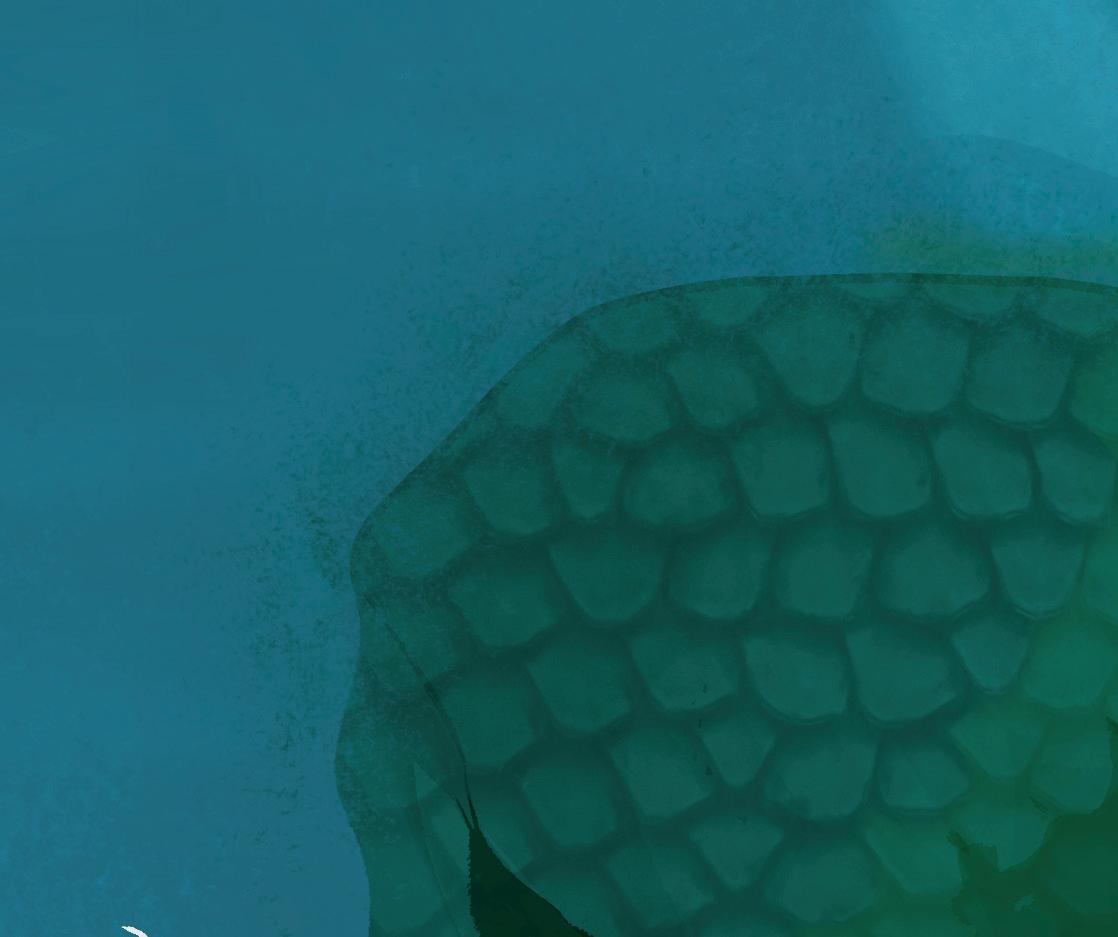



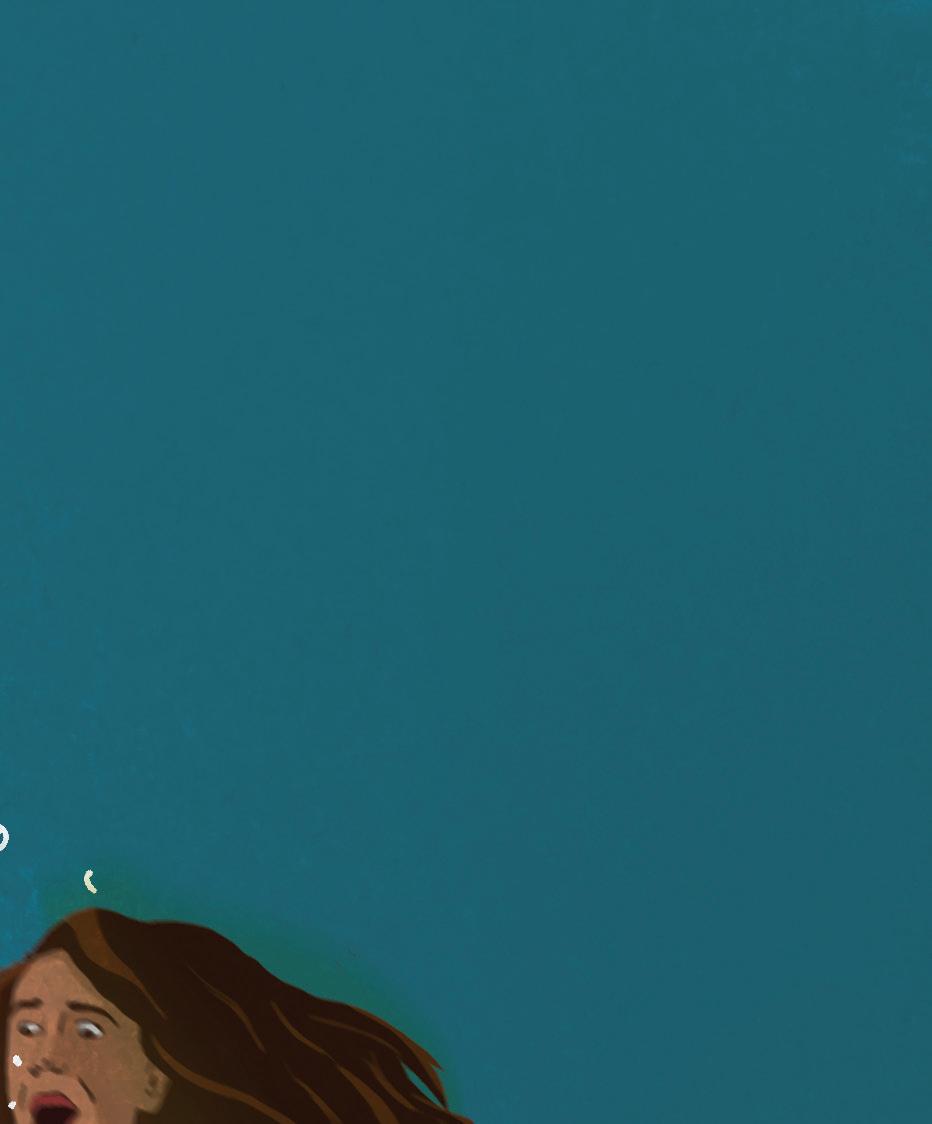

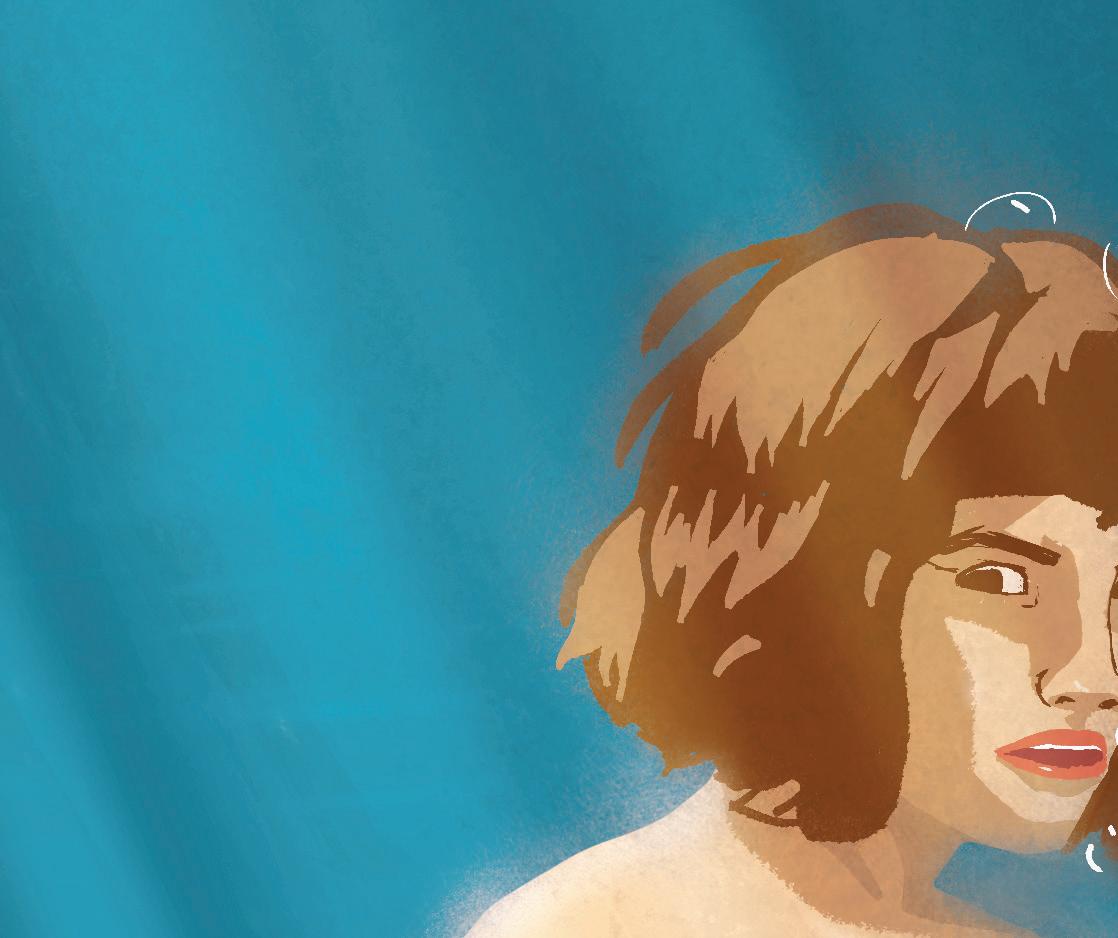





E SER PENT TH ST. JOHNS OF THE













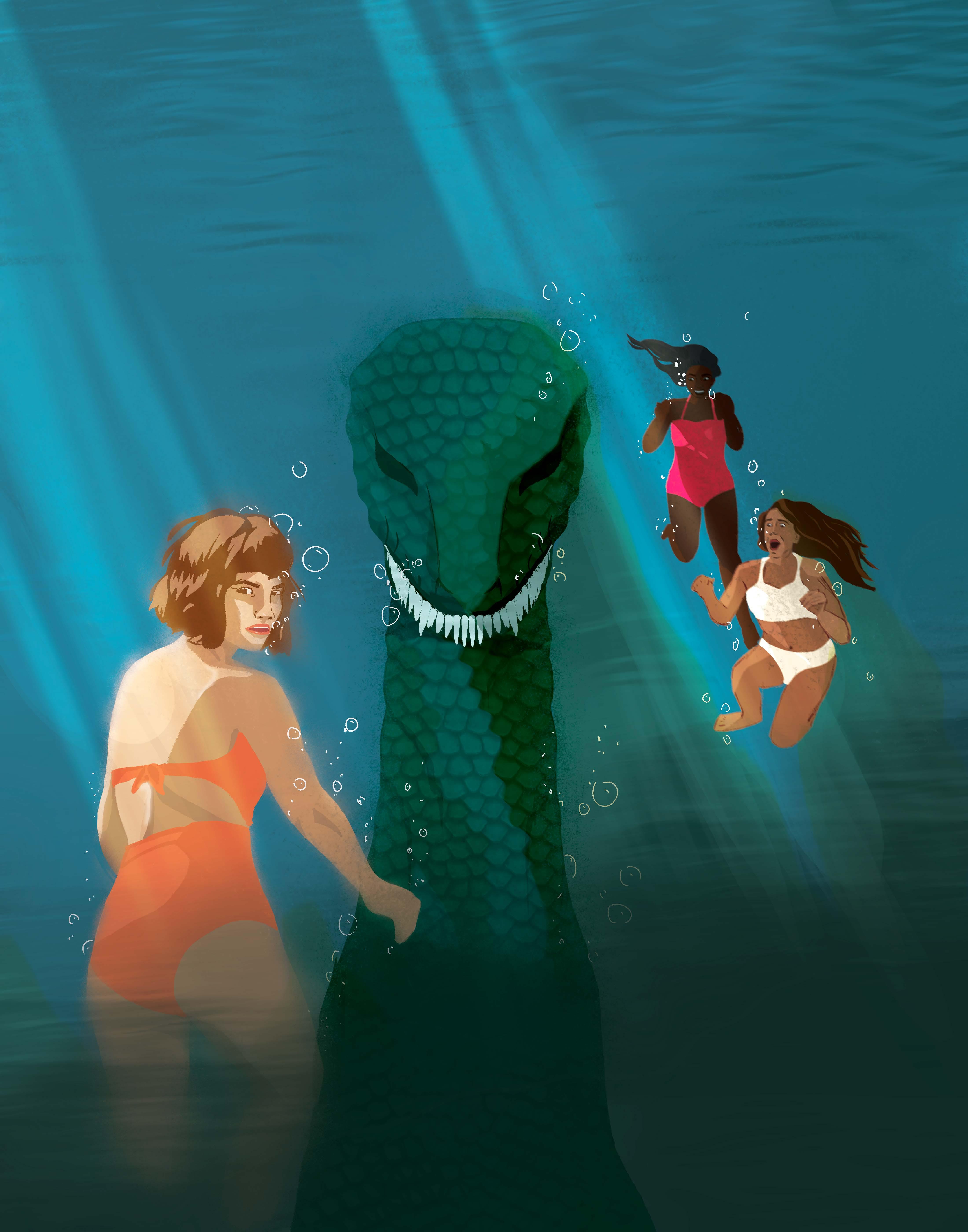


BY TIM GILMORE
1. 2020
It’s been called “Johnnie,” for the river it purportedly calls home, “Borinkus,” inexplicably, by a wisecracking racist state attorney, a “monster,” a “beast” and a “thing.” It’s never been photographed, though several people have expressed regret at not having cameras when they saw it. Someone drew it once, in the 1970s, but a drawing’s not much to go by.
Simon Smith, a keeper of snakes and lizards and an “amateur cryptozoologist,” who lives on Old Gainesville Road on the Westside, claims to have kept track of the St. Johns River Monster for decades.
Smith says people almost always get certain details wrong. For one thing, he says, “Johnnie is a she,” a fact that “should be obvious to anybody ever studied Marine Science.” He considers various testimonies of Johnnie being black or dark gray or brown or beige or pink nonsensical discrepancies. The abrasions of sand and salt and water and sun on skin contribute easily to such a spectrum. He says people have seen Johnnie frequently in the past few years, and probably as reported in my 2016 story, “Beer Hole and Horse-Legged Fish,” but that people today are smarter than to report that fact to “the lamestream media.”
2. 1849
The first account of Johnnie in a mainstream newspaper, Smith says, was in 1849. He has a clipping, but it’s from October 8, 1970, from the Franklin [Indiana] Daily Journal. That day’s “The Way Things Used to Be” column by Verne Vandivier, ostensibly about the Loch Ness Monster, refers to “a monster of the deep” reported by a Captain Adams of a Florida schooner called Lucy and Nancy.
From a newspaper called The Examiner, the Daily Journal quotes the story of Adams, on the 18th of February, 1849, when, at the mouth of the St. Johns River on the coast, “his own and the attention of the crew was riveted upon an immense sea monster which he took to be a serpent.”
The monster “lifted its head, which was like that of a snake, several times out of the water and at such times displayed the most of his body, exhibiting a pair of frightful fins several feet in length.” Adams “judged the leviathan to be about 90 feet in length. Its neck tapered from the head of the body and appeared to be about seven feet across the widest part of the back. The color of the creature was a dirty brown.”
Vandivier assures readers that “the citizens of Jacksonville”
vouched fully for Captain Adams’s character, that “all circumstances” seemed to “favor the idea” of the existence of sea serpents, though scientists had not yet characterized and classified them, and that Jacksonville residents found it “unthinkable” Adams “would invent such a story.”
Vandivier wanted to know whether a “prehistoric beast of the dinosaur age” could exist in modern times and said “documented evidence” existed in Scotland. Though many people “poohpoohed” the idea, “the English Parliament” had recently “set up a bureau” to investigate the Loch Ness Monster.
The infamous 1934 photo of Nessie, the Loch Ness Monster, was long ago proven fake. It’s not clear who vouched for Adams’s character back in Jacksonville. The namesake of Adams Street was the second U.S. president. Whom Captain Adams may have been, nobody knows.
3. 1953
In October 1953, The Orlando Sentinel reported, “That old St. Johns River monster may be an ugly, terrifying creature but he’s worth at least $5,000 to one man.” That’s about $50,000 today.
Owen Godwin, owner of Godwin’s Snake Village in Kissimmee, Florida, was promising to pay five grand for the living monster, or 1K for the slain beast. There was a condition. The sea monster must stretch 30 feet long and have a horn like a narwhal or unicorn. Said the Sentinel, “At least six witnesses said he does.”
It bothers Simon Smith that they had the gender wrong. He’s also doubtful, because of the gender, of the existence of the horn. Smith says he worked with Owen, an okay guy with whom to do shots, but he didn’t like the way he treated some of his serpents, including the anaconda named Big Bertha and her babies.
Former Florida State Attorney J.W. “Jesse” Hunter replied to Orlando Sentinel columnists, “I thought they were extinct.” He referred to “the discovery of the beast, animal, snake or whatever it was, on the St. Johns River.” Back in the 19-teens, “plenty of them” swarmed the St. Johns in various Jacksonville confluences, “and the name for them,” back then, Hunter said, “was Borinkus.”
“Barney Dillard,” he said, a citrus magnate and personal friend, “who still lives at Volusia, used to use a team of them to ferry across the river.”
Jesse Hunter may have been pulling reporters’ legs about “Borinkus,” but he was directly connected to real world monstrosities. He’s best remembered today as the attorney prosecuting the Groveland Boys without evidence.
Sentenced by an all white jury, no evidence presented, the case of the Groveland Boys recalled that of the Scottsboro Boys, the nine Black teenagers falsely accused of the same crime in Alabama in 1931.
The accusations led to white mob attacks on Black families. Headlines spoke of the Klan burning “negro homes” and firing gunshots into the “negro section” of town. In short order, 1) the U.S. Supreme Court ordered a new trial, 2) Sheriff Willis McCall handcuffed and shot two of the Groveland Boys, Sammy Shepherd and Walter Irvin, killing Shepherd, 3) Harry T. Moore, director of Florida operations for the National Association for the Advancement of Colored People, demanded McCall be indicted for murder, and 4) the Ku Klux Klan bombed Moore’s house, killing him and his wife.
In Florida, even when you dig into legends of sea monsters, you unearth lynchings and massacres. In October 1953, 63 years

Owen Godwin, owner of Godwin’s Snake Village in Kissimmee, Florida, was promising to pay five grand for the living monster, or 1K for the slain beast.
COURTESY OF JAX PSYCHO GEO






